
Icelandic Sheep: The Ultimate Guide
- What to Know About the Icelandic Sheep
- History of the Icelandic Sheep
- Icelandic Lamb Has a Protected Designation of Origin
- Forystufé: The Unique Icelandic Leader Sheep
- Sheep in Icelandic Nature
- Icelandic Sheep Roam Free in Summer
- Réttir - Sheep Sorting in Iceland
- Watch Out for Sheep When Driving in Iceland!
- Traditional Icelandic Lamb Dishes
- What to Know About Icelandic Wool
- Best Icelandic Wool Souvenirs
- FAQ's About the Icelandic Sheep
- How many Icelandic sheep are in Iceland?
- Are Icelandic sheep wild?
- Why is Icelandic lamb meat special?
- What is the color of Icelandic sheep's wool?
- Are Icelandic sheep raised outside of Iceland?
- Can Icelandic sheep be kept as pets?

Anyone planning summer self-drive tours in Iceland will spot the adorable Icelandic sheep grazing in the grassy mountainsides around the country. It's said that there are more sheep than people in Iceland, and they famously roam free around the countryside during the warmer months before being herded and sorted in the fall for shelter over winter.
The Icelandic sheep are an inseparable part of the surrounding summer landscapes and integral to Icelandic culture. With a history dating back over a thousand years, these sheep are among the purest breeds in the world, having been isolated on the island since the end of the Viking era. This has let them adapt to the island's harsh climate and rugged nature, developing strong instincts and prized dual-coated wool that has kept Icelanders warm for centuries!
Whether exploring the countryside by renting a car or embarking on exciting tours in Iceland from your Reykjavik accommodation, encountering these animals is inevitable. Read on for all the information you need about the unique Icelandic sheep and why they're such a cherished part of the nation’s identity. Learn about the summer free-ranging practice, the "réttir" sheep gatherings, Icelandic wool, the POC-certified Icelandic lamb, and more!
- Discover the Best Farms You Can Visit in Iceland
- Learn more about Wildlife and Animals in Iceland: The Complete Guide
What to Know About the Icelandic Sheep

With its long history and unique characteristics, the Icelandic sheep is just as much a part of Iceland as the mountains, glaciers, and waterfalls. Here's all you need to know about what makes the Icelandic sheep so special!
History of the Icelandic Sheep
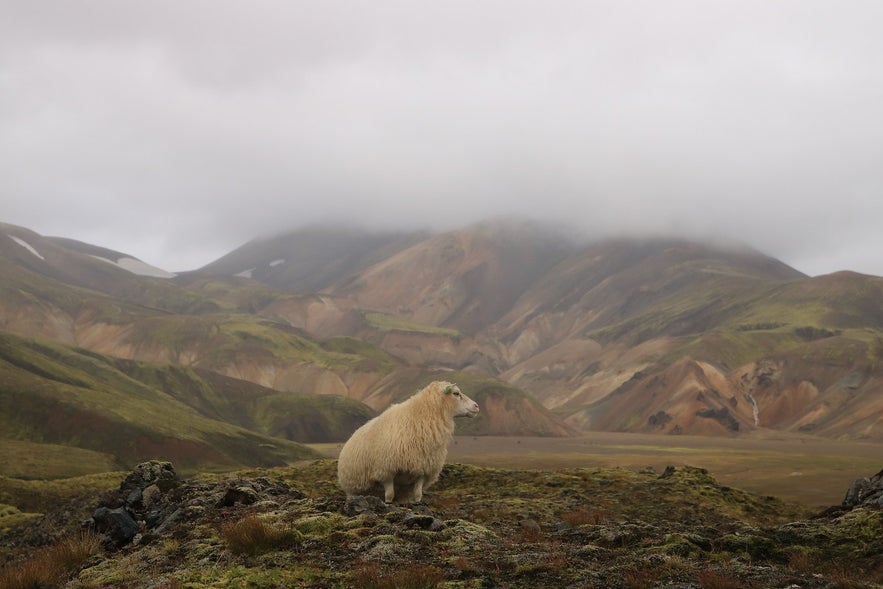
Photo by tsnoni. You'll see sheep all over Iceland!
The Icelandic sheep traces its origins back over 1,100 years to the settlement of Iceland by the Norse people. When the first settlers arrived in Iceland around 871 AD, they brought livestock over with them, including sheep, essential for survival in the harsh and remote environment. These early sheep were primarily of Scandinavian and Northern European origin, closely related to the short-tailed sheep found in Norway and other northern regions.
Over time, the Icelandic sheep have developed into a distinct breed, shaped by the island's isolated geography and challenging climate. The sheep’s genetic makeup remained largely undisturbed due to Iceland's isolation and strict import restrictions, so the Icelandic sheep remained highly adapted to the specific conditions of Iceland.
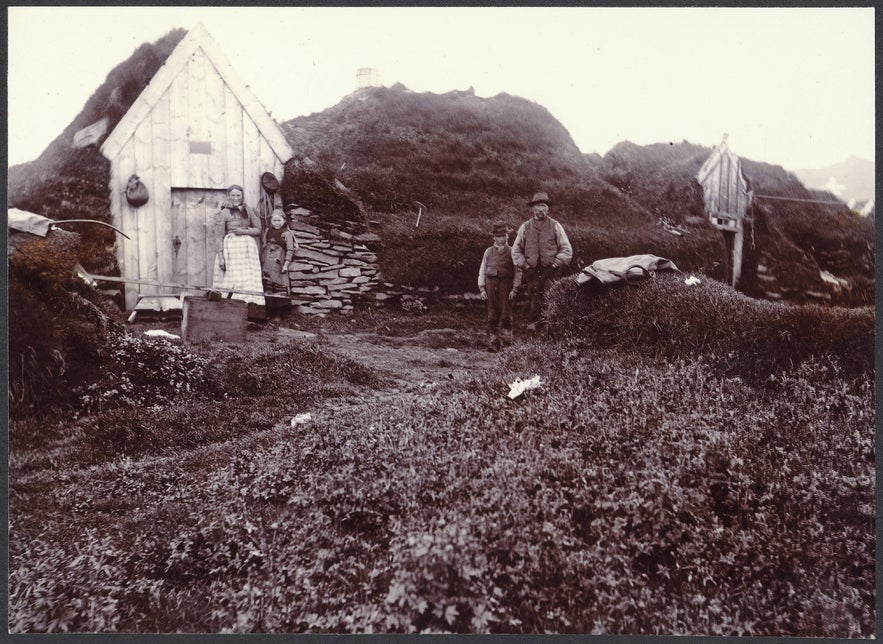
Photo from Creative Commons, Wikimedia, by Cornell University Library. Icelandic farms were made from turf and rocks until the early 20th century.
While Iceland is known today for its fishing industry, nearly all Icelanders predominantly practiced sheep farming from settlement until the late 19th century! Today, there are just over 400,000 sheep in Iceland, nearly matching the country's human population, which is just below that number. To put those numbers in context, in 1760, Iceland had around 357,000 sheep, while the human population was only about 44,000!
Just two decades later, in 1883, the number of sheep had plummeted to around 50,000 due to the catastrophic Lakagigar volcanic eruption, which also led to a 50% decrease in the number of cattle and horses. This disaster triggered a famine that reduced Iceland's human population by 20%!
This is why it can't be understated how important the Icelandic sheep has been for the survival of Icelanders through the centuries. The meat of the Icelandic lamb was a key component of the local diet and is still regarded by many as one of the finest elements of Icelandic cuisine.
- Learn more: Volcanic Eruptions in Iceland: A History of Fire
- See also: Iceland's Volcanoes: The Complete Guide
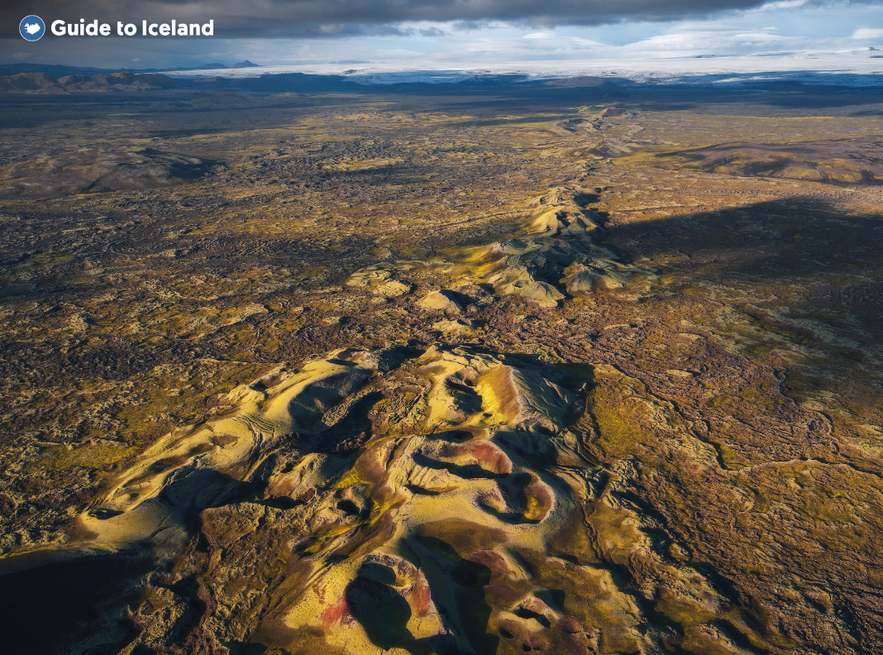
The Lakagigar craters are an incredible sight in the Icelandic Highlands.
Additionally, the Icelandic wool was an essential resource, providing fantastic material for clothing against the harsh climate. It was integral for the country's economy, as the Icelandic wadmal or "vaðmál," a woven wool fabric, was the main form of currency for centuries and was used for trade around the world!
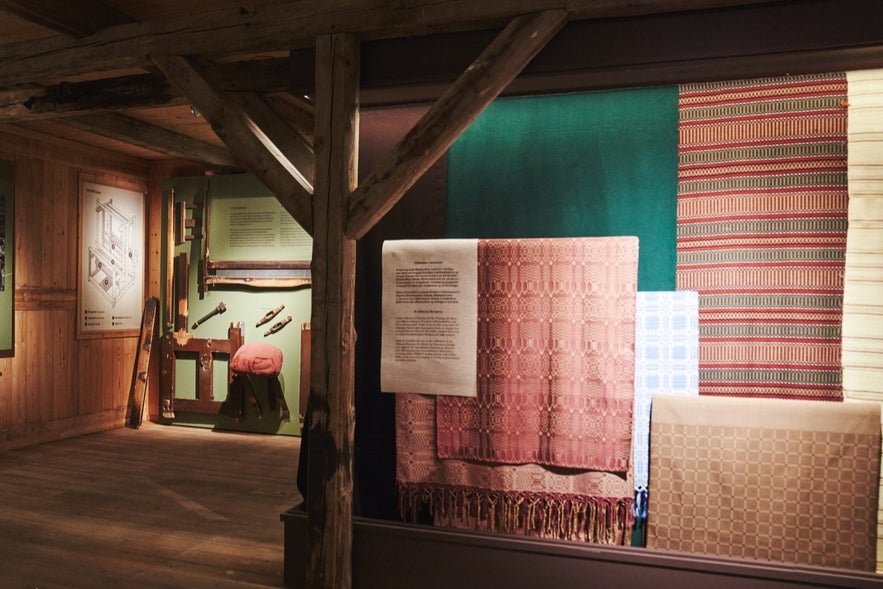
Photo from Reykjavik City Museum, Icelandic wool weaving by Karólína Guðmundsdóttir (1897-1981) on display at the Arbaejarsafn open-air museum.
Today, Icelandic sheep are recognized as one of the oldest and purest domesticated breeds, continuing to play a vital role in the country's agricultural heritage and economy. Sheep farming remains a cornerstone of Icelandic life, producing high-quality wool and lamb. For travelers, getting to know the significance of these sheep provides a unique insight into the traditions and resilience that have shaped life on this remote island, making a visit more meaningful.
- Discover more with a visit to some of the Best Museums in Iceland
- See also: Ultimate Guide to Cultural Tours in Iceland
Icelandic Lamb Has a Protected Designation of Origin
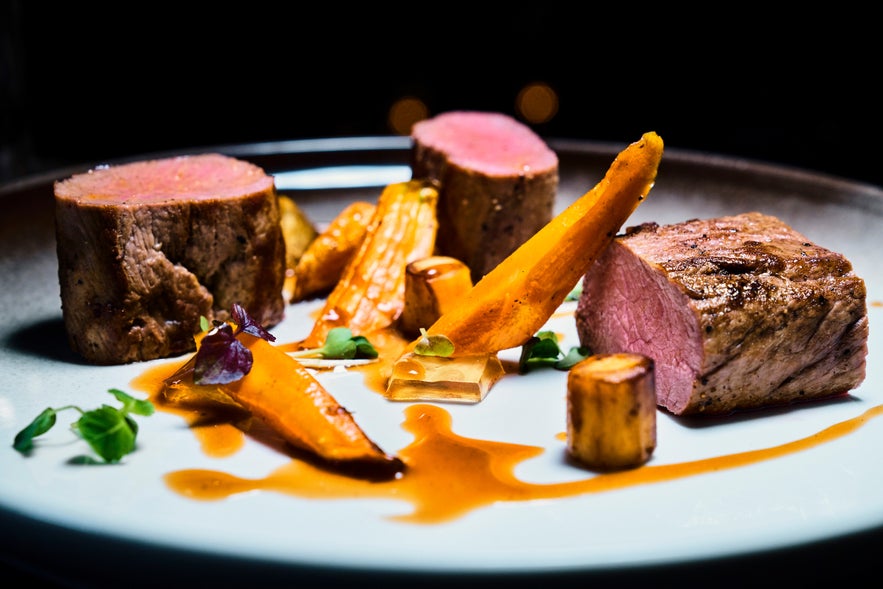
Icelandic lamb is served in many fantastic restaurants in Iceland.
Icelandic lamb is highly regarded for its quality and unique flavor, which is attributed to the sheep's natural diet and free-range lifestyle. These lambs graze on wild grasses, herbs, and berries in the countryside, giving their meat a distinct taste that's tender and very flavorful. It's very different from mutton, and Icelandic lamb is often enjoyed by those who usually don’t like lamb!
Since 2023, Icelandic lamb has had a Protected Designation of Origin (PDO), recognizing the lamb's quality. Icelandic lamb meets strict criteria for authenticity and production, ensuring its status as a genuine Icelandic product, making it a staple in local cuisine and sought after internationally.
This is why tasting Icelandic lamb is a must during a visit to Iceland. Some of the best restaurants in Reykjavik feature Icelandic lamb on their menus, and you can try it as part of traditional dishes such as the kjötsúpa meat soup. It's also an ingredient in the famous Icelandic hot dog and part of why it has such a special flavor!
- Learn all about Icelandic Food: The Ultimate Guide to Iceland Food Culture
Forystufé: The Unique Icelandic Leader Sheep
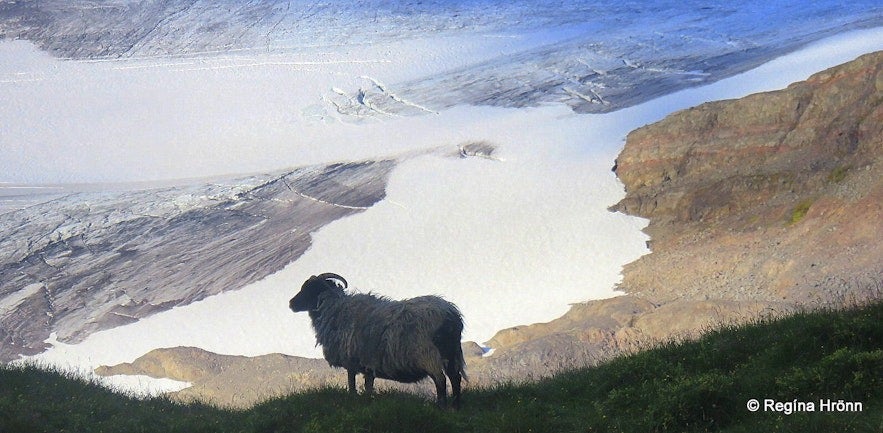
Photo from Regína Hrönn Ragnarsdóttir. The Icelandic leader sheep has saved many lives through the centuries.
The Icelandic leader sheep, known as "forystufé," are a rare and specialized subset of the Icelandic sheep breed, highly valued for their exceptional intelligence and leadership abilities. Unlike regular sheep, forystufé leader sheep are known to have strong instincts and an innate sense of direction, often taking the lead in navigating the flock through snowstorms, fog, or rivers.
During sudden storms or extreme weather, these brave Icelandic sheep have been credited with saving entire flocks, and even people, by leading them to safety. Their remarkable ability to detect subtle atmospheric changes allows them to sense approaching storms, often before any visible signs appear. This was very helpful throughout history because if the leader sheep refused to stray far from the farmhouse, farmers would recognize it as a warning of impending bad weather!
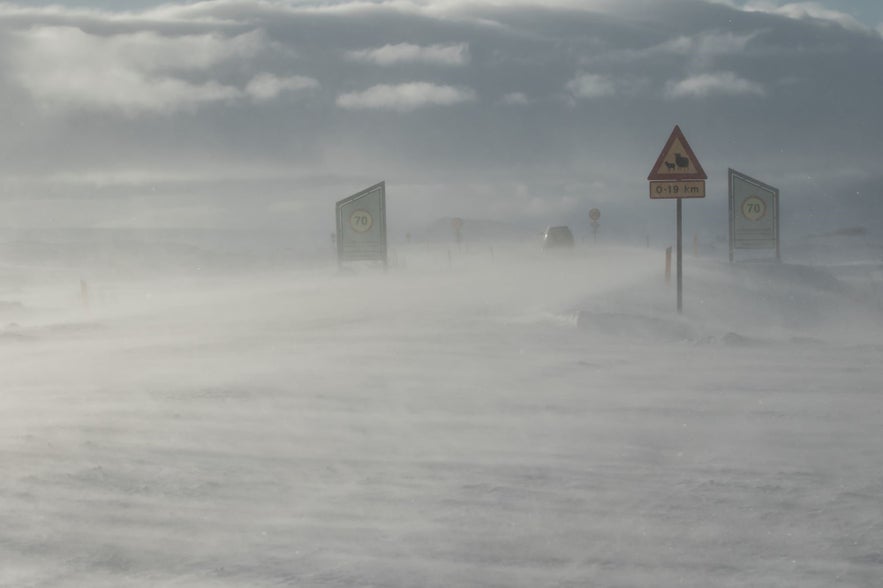
The weather in Iceland can be challenging, especially over the colder months. Today, sheep are kept inside over winter, but this was not always the case.
Leader sheep were highly valued, often marked with a copper bell in one horn. However, throughout the 20th century, as sheep grazing practices changed and flocks were brought inside during colder months, the need for leader sheep diminished. Today, only around 1,400 leader sheep remain, all originating from Northeast Iceland!
If you're traveling to North Iceland, you can learn more about this unique sheep at the Study Center on Leader Sheep, known locally as "Fræðrasetur um forystufé." While there, you can even buy yarn made from the wool of leader sheep, which is excellent for sweaters.
Not only does it have the same properties as regular Icelandic wool, warm and water-resistant, but it's said to bring the additional benefit to the wearer that they will never get lost and always find their way back home!
- Learn more: The Study Centre on Leader-sheep in North-East Iceland
- See also: 11 Must-See Destinations in North Iceland
Sheep in Icelandic Nature
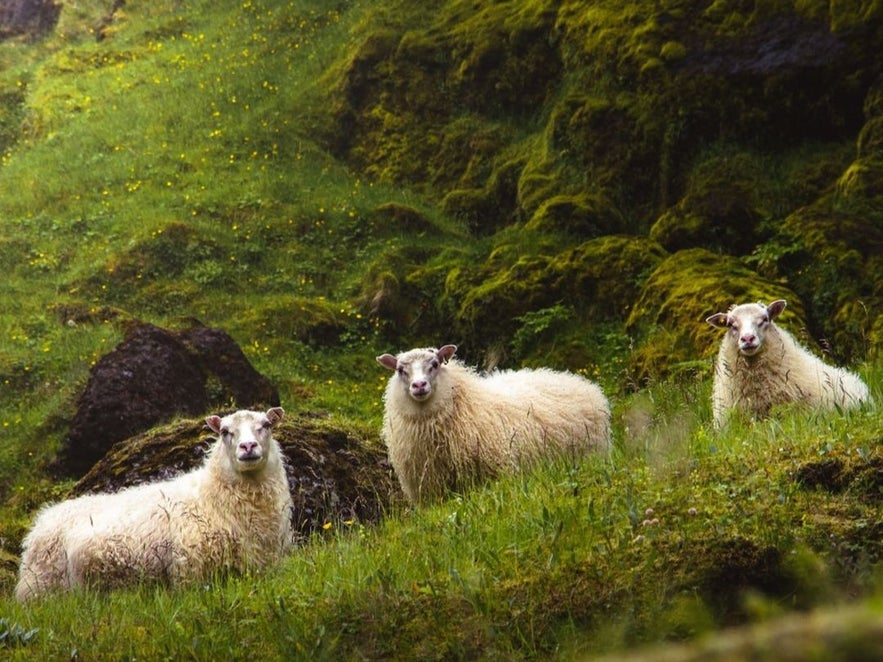
You'll spot sheep in the unlikeliest of places all around Iceland! Here's all you need to know about sheep in the wild and how they affect the surrounding nature.
Icelandic Sheep Roam Free in Summer
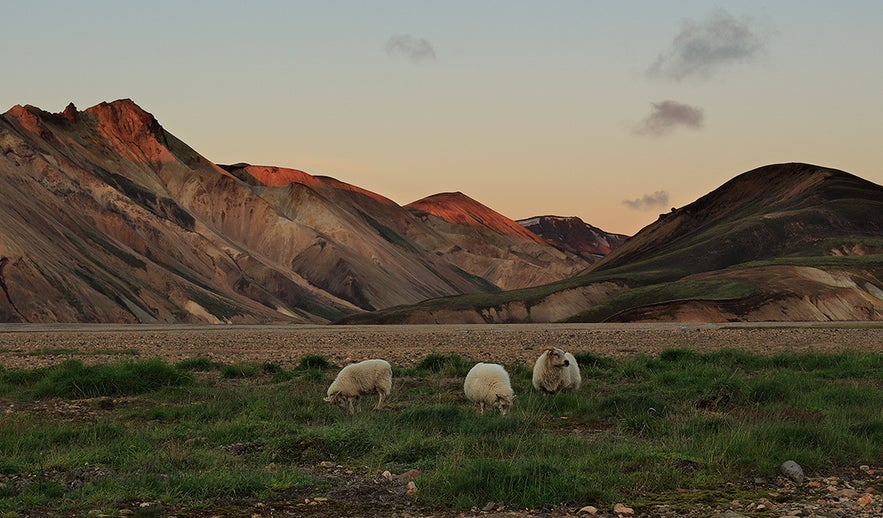 If you're visiting Iceland in summer, spotting the Icelandic sheep is pretty much unavoidable. No matter where you go, whether you're sticking to Ring Road tours or going on Highland adventures, you'll see sheep grazing in the grassy mountainsides.
If you're visiting Iceland in summer, spotting the Icelandic sheep is pretty much unavoidable. No matter where you go, whether you're sticking to Ring Road tours or going on Highland adventures, you'll see sheep grazing in the grassy mountainsides.
This traditional practice, known as free-range grazing, allows the sheep to enjoy the natural vegetation found in Iceland’s landscapes. The sheep graze on grasses, herbs, and other wild plants, which contribute to the distinct flavor of Icelandic lamb meat.

Sheep roaming along the sides of Fjadrargljufur canyon in South Iceland.
Sheep are generally left to their own devices for several months, from late spring until early autumn, when they are herded back to the lowlands. However, this hasn't always been the case and is a rather contentious topic.
While many farmers consider free range the best approach for the sheep, there are concerns about land preservation. Great regions of Iceland have very fragile vegetation, and sheep don't really care about such things. If they see a tasty spot of grass or flowers, they will eat away without consulting any environmental protection groups!
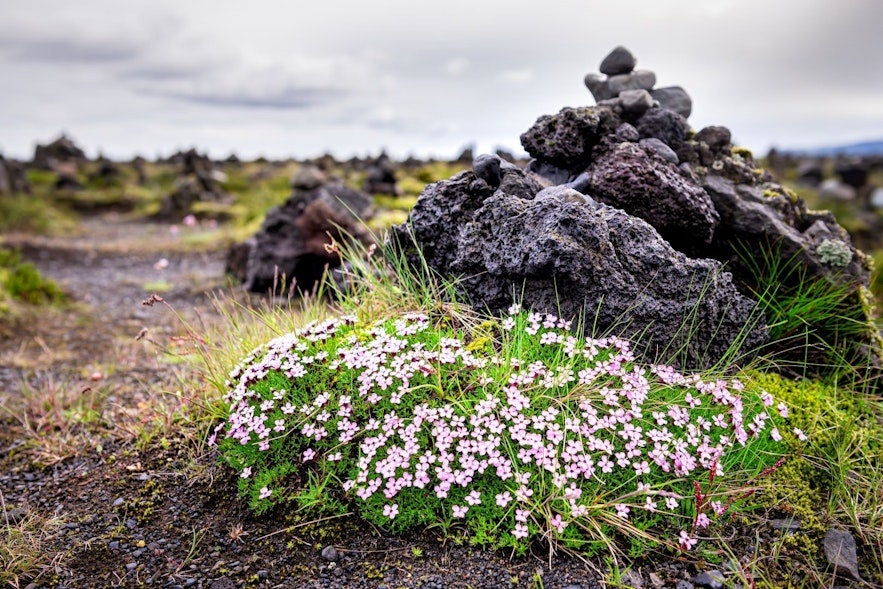
Iceland's flora can be very fragile.
Additionally, if they roam on private land, it is the responsibility of the land owner, not the sheep farmer, to ensure the wellbeing of the sheep. The only thing the landowner can do is to contact the farmer or the county to have them removed, but this can take a while. At the same time, sheep munch on the landowner's potted summer plants, private herb gardens, and growing trees and may return again for more once they've been removed!
Combined with the road dangers of roaming sheep, there have been calls among locals to change these free-roaming laws. The change would make the farmer responsible for keeping the sheep away from private land and fragile nature, which actually used to be the norm.
While sheep have always been relatively free, it wasn't until the late 20th century that sheep were allowed to fully roam free like they do today. Despite growing pressure for change, however, it appears that the current laws will continue to shape the landscape (literally and figuratively) for the foreseeable future.
- Check out the Guide to Icelandic Flowers and Herbs
- See also: Plants in Iceland | Flora Under the Arctic Circle
Réttir - Sheep Sorting in Iceland
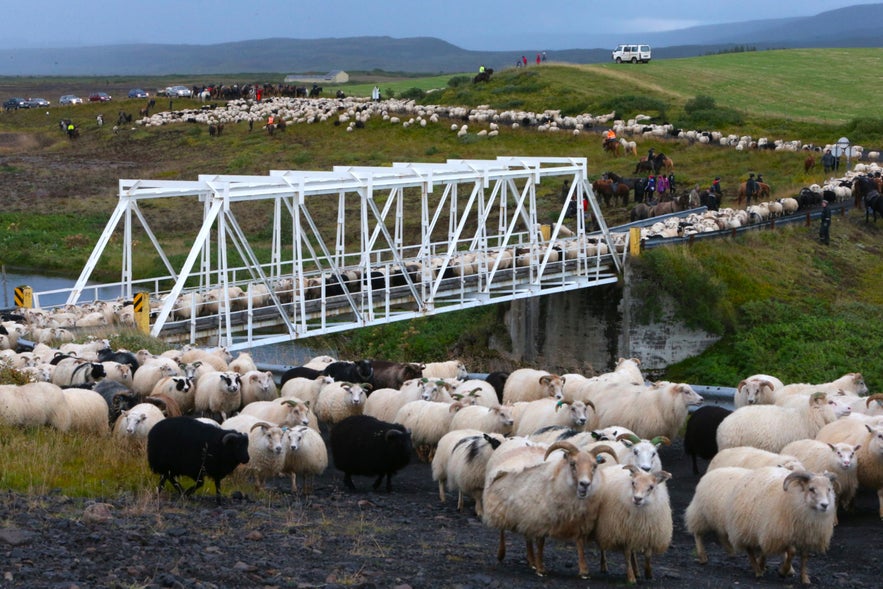
Photo from Creative Commons, Wikimedia, by Dagur Brynjólfsson.
One sheep-related event in Iceland you may have heard about is "réttir," the sheep sorting in the fall. As summer transitions into autumn and the temperature drops, farmers conduct an organized round-up of the sheep, which is a huge community effort!
Sheep round-ups usually occur in September and involve farmers, family members, and volunteers gathering the sheep from vast land areas and returning them to their farms for winter. This is done with Icelandic horses, ATVs, 4x4 vehicles, and on foot, as some areas are hard to access. They're often accompanied by the fluffy Icelandic sheepdog, always eager to help!
- Discover more: Icelandic Sheepdog - Everything You Need to Know
- See also: The Icelandic Horse | A Comprehensive Guide
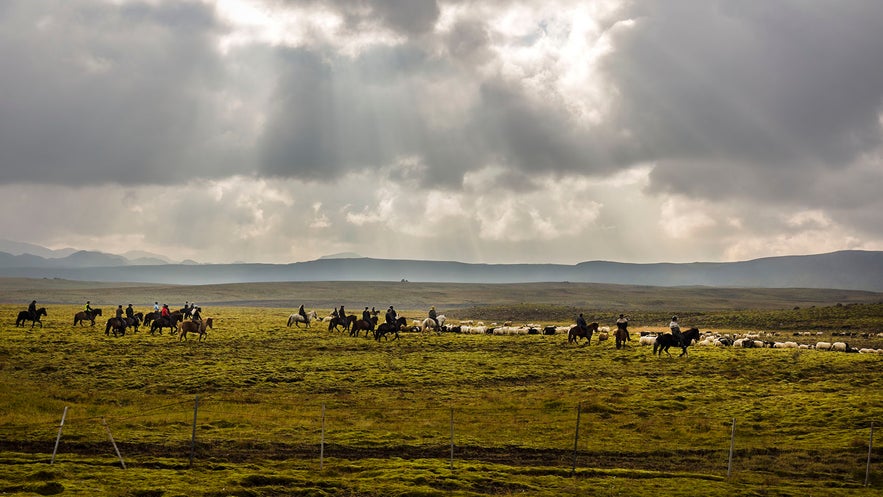
Photo from Creative Commons, Wikimedia, by Hafsteinn Robertsson.
Traditionally, regions have one main person in charge of the round-up, most commonly known as the "fjallkóngurinn" or Mountain King, though other titles exist in different parts of Iceland. They often retain the position for multiple years and organize the sheep search. Knowing the land well is important, especially as some sheep can be very stubborn and good at hiding!
 The whole sheep-gathering process can take several days as Icelandic farmers work to find sheep across large and rugged areas of land. Once the sheep are brought down from the mountains, they are herded into circular stone or wooden pens to start the sorting process.
The whole sheep-gathering process can take several days as Icelandic farmers work to find sheep across large and rugged areas of land. Once the sheep are brought down from the mountains, they are herded into circular stone or wooden pens to start the sorting process.
Sheep are gathered in the center, and farmers identify their own sheep by ear tags or distinctive markings. Each farmer then retrieves their sheep and collects them into a pen so they can bring them back to their farms for the winter.
Sheep sorting in Iceland is a very communal affair. It's common for people raised in the country but living in Reykjavik to return home to participate, both to help out and meet family and friends. The successful round-up is celebrated with food, drinks, and festivities afterward, often with a typical "sveitaball" or country dance.

Unsorted sheep go in the center, and each farmer has their own pen along the edges.
This sheep sorting process marks the end of summer as the air gets colder and the nights much darker. While locals don't want to say goodbye to summer, the next period of the year can also be magical as the fall colors soon take over nature. Iceland is incredibly beautiful in the fall, draped in yellow, orange, and red hues, and it also marks the start of the northern light season!
If you get the chance to visit Iceland in autumn, check with the locals to see if you can participate in a sheep gathering or attend a réttir sorting. At the very least, you may spot the sheep returning from the Highlands, draping the mountainsides like fluffy waterfalls!
- Learn all about visiting Iceland in Fall - The Ultimate Travel Guide
- See also: Northern Lights in Iceland - When & Where To See the Aurora
Watch Out for Sheep When Driving in Iceland!

If you plan to explore Iceland with your affordable rental car, you'll see plenty of sheep along the road while driving. They are supposed to be confined to certain areas, and there are often fences along the roads, but the sheep don't necessarily agree with this idea and find ways to sneak out!
You'll see sheep munching on the tasty grass, sometimes just on the edge of the road, and this is where things can get dangerous. Sheep spook easily, especially the tiny lambs, and sometimes, their instinct pushes them to run away when they see a car. If you see a sheep and lamb on either side of the road, the lamb will run to its mother, even if it means heading straight into the path of your car!
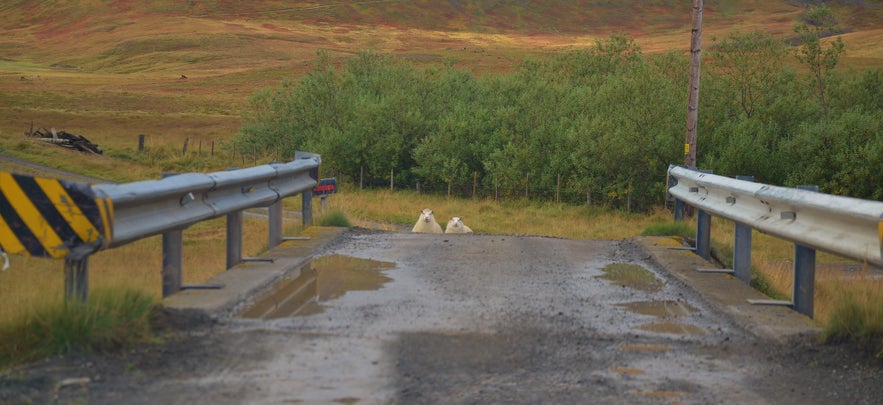 Because of this, it's extremely important to keep your focus on the road while driving in Iceland and check for sheep grazing along the sides. Accidentally hitting a sheep is not just horrible for the poor, unsuspecting sheep; it can be life-threatening for those in the car.
Because of this, it's extremely important to keep your focus on the road while driving in Iceland and check for sheep grazing along the sides. Accidentally hitting a sheep is not just horrible for the poor, unsuspecting sheep; it can be life-threatening for those in the car.
But what should you do if you hit a sheep in Iceland? Make sure to pull over in the nearest safe spot and call 112 to inform the police. The owner of the sheep can then be tracked down. Farmers are insured for these types of accidents, so if it wasn't caused by great negligence, such as drunk driving, you generally don't have to worry about a fine.
It's incredibly important to let someone know about the accident and check on the sheep if you can. While these accidents are most often fatal, the sheep may walk away with injuries that require immediate care!
- Learn what you need about Driving in Iceland: The Ultimate Guide to Road Trips
- See also: Best Guide to Rental Car Sizes in Iceland
Traditional Icelandic Lamb Dishes

Photo taken from Icelandic Lamb.
Traditional Icelandic lamb dishes are a cornerstone of the country's cuisine and one of the best things to try during a visit. One of the most beloved dishes is the roasted leg of lamb, which is often enjoyed with potatoes, gravy, and sometimes a side of peas and pickled red cabbage. It’s a popular option for family gatherings like Easter and is one of our favorite Icelandic dishes!
Similarly, "hryggur," or roasted lamb rack, is a common festive dish, often prepared for celebrations like Christmas and Easter. Another iconic festive dish is "hangikjöt," a smoked lamb usually only served during Christmas. It's typically boiled and paired with potatoes, peas, and a béchamel sauce.
- Discover Christmas in Iceland | Your Ultimate Guide to Christmas Traditions, Food, and More!
- See also: The Icelandic Yule Lads and Gryla | Iceland's Christmas Trolls
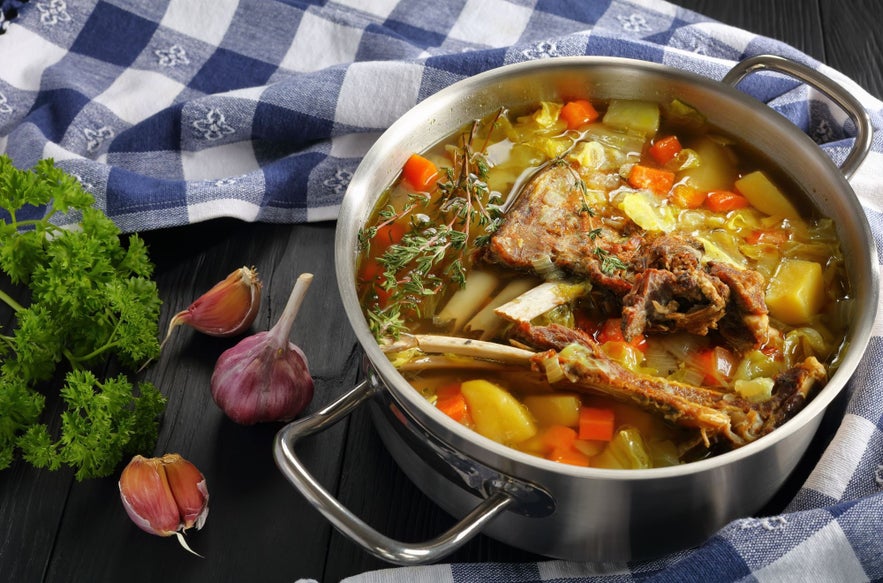
The traditional Icelandic lamb soup, or "kjötsúpa," is the perfect meal on a chill autumn night, and even better when warmed up the next day!
Day-to-day, you can find pre-sliced hangikjöt smoked lamb in most grocery stores, as it's the perfect topping for a sandwich or on the more typical "flatkaka" flatbread! Another sandwich topping to try is the "kindakæfa" lamb pâté, which Icelanders have prepared for centuries and is still very popular today.
For everyday meals, "kjötsúpa" is a comforting lamb soup made with root vegetables such as carrots, potatoes, and rutabagas. It's the perfect dish to warm up during Iceland’s colder seasons but can usually be found year-round.
If you're visiting Iceland in February, you can try the traditional hearty dish "saltkjöt and baunir," or salted meat and split pea soup. This dish is only eaten on "sprengidagur," or bursting day, the Tuesday before Lent. As the name suggests, you're supposed to eat until you burst, but be mindful! The dish is incredibly salty, so it's best to have moderate servings and a glass of cold water on the side.
- Learn all about Iceland in Winter - The Ultimate Travel Guide

Photo from Wikimedia, Creative Commons, by The blanz. No edits made.
If you want to try some of the more infamous traditional dishes in Iceland, well... you have some options. You can try the "svið," a boiled sheep's head that's typically served with mashed potatoes and turnips. There are also the "súrsaðir hrútspungar," or pickled Icelandic ram testicles, a staple on any traditional food platter.
These dishes are relics from a time when Icelanders truly had to use every part of the animal to have enough food over winter, so they don't make a regular appearance as a weeknight dinner today. However, like the famous fermented shark, they are worth tasting for the novelty, and they're often included in food and drink tours where you can try many different dishes at once. Don't worry, though; there will also be plenty of the more appealing dishes to try!
- Learn more about Disgusting Food in Iceland
- See also: A Complete History of Iceland
What to Know About Icelandic Wool
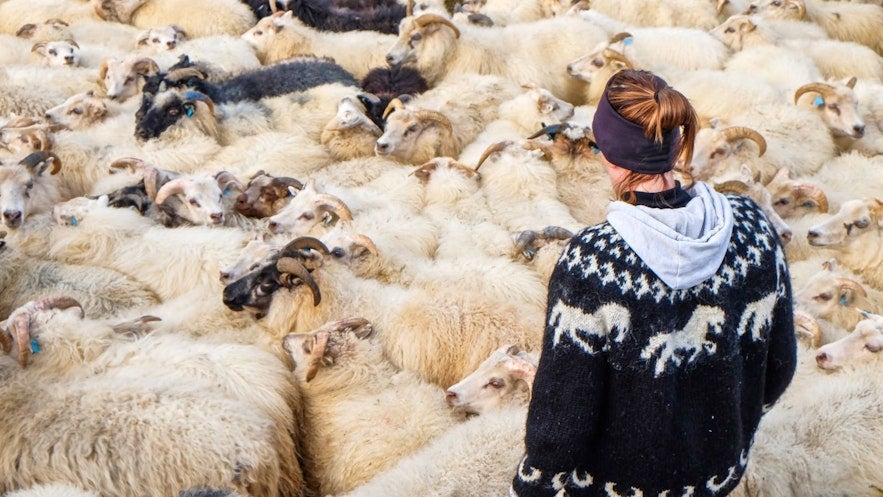 One of the things that make Icelandic sheep so special is their high-quality fluffy wool, which keeps them warm in all weather. It has a dual-layer structure, which provides excellent insulation and durability!
One of the things that make Icelandic sheep so special is their high-quality fluffy wool, which keeps them warm in all weather. It has a dual-layer structure, which provides excellent insulation and durability!
The Icelandic sheep wool consists of two types of fibers: "þel," the soft, insulating undercoat, and "tog," the coarser, water-resistant outer layer. This combination creates a versatile material suitable for different uses, from lightweight, warm clothing to strong, weather-resistant outerwear.
The þel fibers are fine and soft, making them ideal for creating garments that require warmth and comfort, such as sweaters, scarves, and gloves. On the other hand, the tog fibers are longer and coarser, providing strength and resilience, making them suitable for items like blankets, rugs, and outerwear that need to withstand harsher conditions. Sometimes, they are combined to make the most of both fibers.
Additionally, Icelandic sheep wool contains a natural substance called lanolin, which contributes to the wool's water-resistant properties. Lanolin is a waxy coating that coats the wool fibers, helping to repel moisture and protect the sheep from the wet and cold conditions of Iceland's climate!
This all makes Icelandic sheep wool naturally breathable and lightweight, so it's perfect for a wide range of clothing and textiles. Whether used in traditional lopapeysa sweaters, cozy mittens, or durable outerwear, the wool provides warmth without being overly heavy, making it comfortable to wear in various conditions!
Best Icelandic Wool Souvenirs

There are strict rules around what sweaters can be called authentic lopapeysa!
If you're craving a piece of Iceland to bring back home with you after a trip, wool souvenirs are some of the most popular items! The best thing to get is the authentic Icelandic sweater known as "lopapeysa," but hats, scarves, mittens, and blankets are all great alternatives. You can even find artwork made from Icelandic wool!
You'll find plenty of wool items in shops across the country, which are often made by local knitters or small businesses. It's practical for taking on the Icelandic weather during your trip, is sure to last for a long time, and it's a fun reminder of your adventures!
- Learn more: Lopapeysa: Ultimate Guide to Traditional Icelandic Sweaters and Wool
- Also, discover the Top 10 Souvenirs from Iceland
FAQ's About the Icelandic Sheep
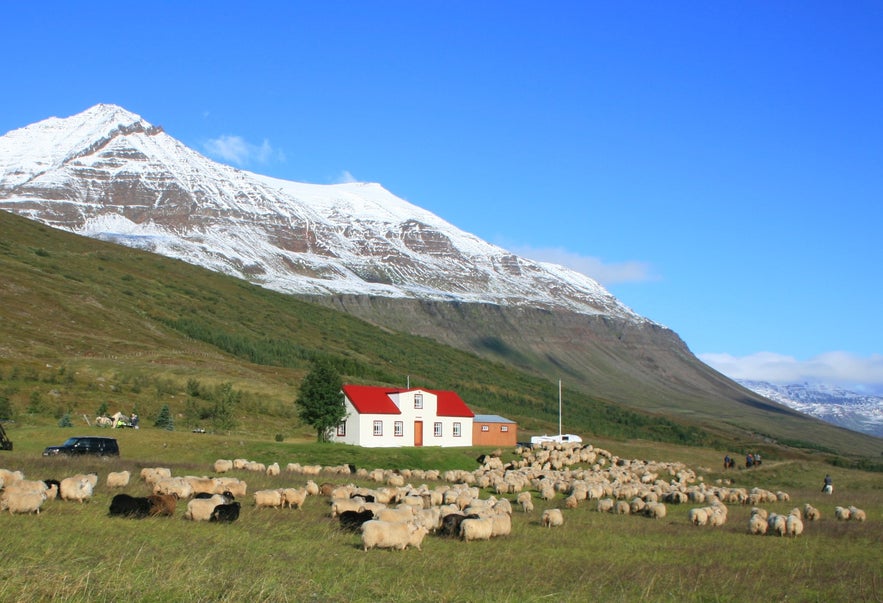
Photo from Creative Commons, Wikimedia, by Ahjartar.
Haven't found the answer you're looking for? Here are some frequently asked questions about Icelandic sheep!
How many Icelandic sheep are in Iceland?
It's commonly said that there are more sheep than people in Iceland, and it's true! There are just over 400,000 Icelandic sheep in Iceland, while the human population is around 380,000.
Are Icelandic sheep wild?
Although Icelandic sheep are often left to roam freely in the Highlands and rural areas during summer, they are not wild. They are domesticated animals managed by farmers, and they are herded back to farms in the fall for shelter and care over the winter.
Why is Icelandic lamb meat special?
Icelandic lamb is known for its tenderness and unique flavor, often attributed to the sheep’s natural diet of wild grasses, herbs, and berries. The meat is free-range and generally free of hormones and antibiotics, making it a sought-after product locally and internationally.

What is the color of Icelandic sheep's wool?
While white and yellow wool is most common, Icelandic sheep come in a wide range of colors! You can spot white, black, brown, and gray sheep as you travel around the country. Some even have multicolored coats, which is especially common among the unique leader sheep breed.
Are Icelandic sheep raised outside of Iceland?
While Icelandic sheep are most commonly found in Iceland, some have been exported to other countries, particularly for their wool and adaptability to cold climates. However, the breed remains most concentrated in Iceland.
Can Icelandic sheep be kept as pets?
While Icelandic sheep are not typically kept as pets, they can make affectionate and intelligent companions for those with the appropriate space and resources! In fact, Icelandic lambs that have been rejected by their mothers are usually raised by farmers. They're known as "heimalingar" and they often become a special member of the human household.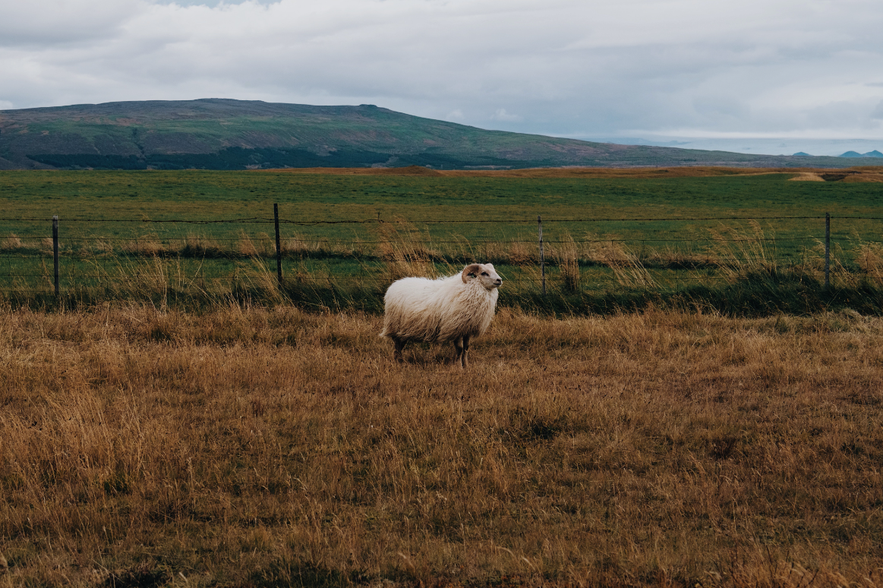
Will you travel around Iceland next summer? Would you get a traditional wool sweater? Have you tried Icelandic lamb before? Share your thoughts and experiences with us in the comment section below!
Other interesting articles

Iceland in Winter - The Ultimate Travel Guide
Iceland is known for its dramatic landscapes, and during winter, they take on an ethereal quality. It's an ideal time to enjoy the northern lights, go ice caving, or embark on a snowy adventure. Exper...Read more
What to Wear in Iceland: The Ultimate Guide for All Seasons
Iceland is infamous for its ever-changing weather, with mild winters and often cool and windy summers. Packing for a country with weather gods prone to mood swings can seem daunting, but don't worry -...Read more
Top 11 Waterfalls in Iceland to See in Winter
Explore the amazing frozen waterfalls you can see in Iceland during the winter. Find out where they are, how to get there, and all the fascinating stories behind these beautiful waterfalls. When vi...Read more

Download Iceland’s biggest travel marketplace to your phone to manage your entire trip in one place
Scan this QR code with your phone camera and press the link that appears to add Iceland’s biggest travel marketplace into your pocket. Enter your phone number or email address to receive an SMS or email with the download link.





















